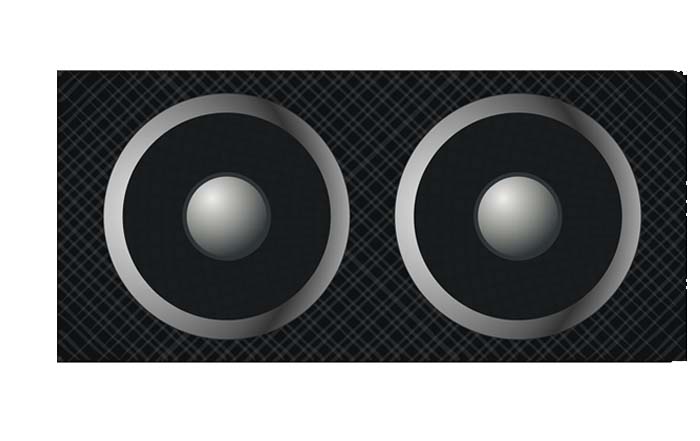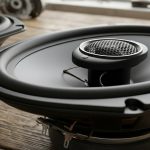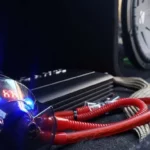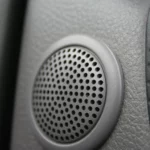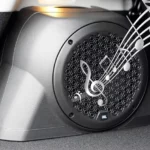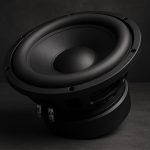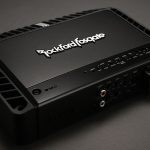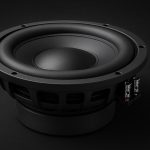The size of the amp you need for 2 12s depends on the power rating and impedance of your subs, as well as the quality of your amp. A general rule is to look for an amp that can deliver at least twice the RMS rating of your subs at the total impedance of the subs. For example, if you have two 12-inch subs with 400 watts RMS each and 2 ohms each, you’ll need an amp that can deliver at least 800 watts RMS at 2 ohms or 1-ohm, depending on how you wire your subs. However, this is not the only factor to consider. You also need to choose an amp that is efficient, reliable, and compatible with your subs.
If you have 2 12-inch subwoofers in your car, you may be wondering what size amp you need to power them. Choosing the right amp for your subs is not as simple as picking the one with the highest wattage. You also need to consider the impedance, efficiency, and quality of your amp and subs. In this article, we’ll explain how to find the best amp for 2 12s and what factors to look for when shopping for one.
Explaining What An AMP Is And Its Role In Powering Speakers
An amplifier (AMP) is a device that increases the amplitude of audio signals, allowing them to be played through speakers at higher volumes. Amplifiers are essential for powering speakers because they provide the necessary electrical current to drive the speaker cones and produce sound waves. The role of an AMP is to take a weak audio signal from a source (such as a receiver or audio player) and amplify it to a level that can drive the speakers effectively.
Amplifiers come in various types and configurations, including mono amplifiers, 2-channel amplifiers, and multi-channel amplifiers. The choice of amplifier depends on the specific requirements of the audio setup. In the case of powering 2 12s speakers, a 2-channel amplifier is commonly used. This type of amplifier can deliver a separate sound signal to each sound system, providing stereo sound.
When choosing an amplifier for 2 12s speakers, it is essential to consider the power requirements of the speakers. Each sound system will have a specific power handling capability, often expressed in terms of wattage. It is important to choose an amplifier or sound booster that matches or slightly exceeds this power handling capability to ensure optimal performance and prevent damage to the speakers. Additionally, the impedance of the sound system (measured in resistor unit) should be compatible with the amplifier’s impedance rating to achieve the best sound quality.
Related Post: How Many Speakers Are In My Car: Decoding Car Speaker Numbers
What Size Amp For 2 12s
If you have two subwoofers in your car, you might be wondering what size amp you need to power them. The answer is not so simple, as it depends on several factors, such as:
- The power rating of your subs
- The resistance of your subs
- The wiring configuration of your subs
- The power outcome of your amp
- The quality of your amp
In this article, we’ll explain each of these factors and give you some general guidelines on how to choose the right amp for your 2 12s.
The Power Rating of Your Subs
The power rating of your subs tells you how much power they can handle and how much power they need to perform well. The power rating is usually expressed in watts (W) or root mean square (RMS) watts.
The higher the power rating, the more powerful the subs are. However, this also means that they need more power to drive them. If your subs have a high power rating and your amp can’t provide enough power, you’ll end up with distorted and weak sound.
On the other hand, if your subs have a low power rating and your amp provides too much power, you’ll risk damaging your subs. You’ll also waste energy and generate heat.
The ideal situation is to match the power rating of your subs with the power outcome of your amp. This way, you’ll get the optimal sound quality and performance from your subs.
The Impedance of Your Subs
The impedance of your subs tells you how much resistance they offer to the electrical current from your amp. The resistance is usually expressed in ohms (Ω).
The lower the impedance, the less resistance the subs offer. However, this also means that they draw more current from your amp. If your subs have a low resistance and your amp can’t provide enough current, you’ll end up with overheating and clipping issues.
On the other hand, if your subs have high resistance and your amp provides too much current, you’ll end up with underpowering and damping issues.
The ideal situation is to match the resistance of your subs with the resistance rating of your amp. This way, you’ll get the best efficiency and stability from your amp.
The Wiring Configuration of Your Subs
The wiring configuration of your subs tells you how they are connected to each other and to your amp. There are two main types of wiring configurations: series and parallel.
Series wiring means that the positive terminal of one sub is connected to the negative terminal of another sub, and so on. This increases the total resistance of the subs.
Parallel wiring means that the positive terminals of all the subs are connected together, and the negative terminals of all the subs are connected together. This decreases the total resistance of the subs.
The ideal situation is to choose a wiring configuration that matches the resistance rating of your amp. This way, you’ll get the best compatibility and performance from your amp.
The Power Output of Your Amp
The power output of your amp tells you how much power it can deliver to your subs. The power output is usually expressed in watts (W) or root mean square (RMS) watts.
The higher the power outcome, the more powerful the amp is. However, this also means that it needs more voltage and current from your electrical system. If your amp has a high power outcome and your electrical system can’t provide enough voltage and current, you’ll end up with dimming lights and battery drain issues.
On the other hand, if your amp has a low power outcome and your electrical system provides too much voltage and current, you’ll end up with wasted energy and heat issues.
The ideal situation is to choose an amp that has enough power outcome to drive your subs without exceeding their power rating or straining your electrical system.
The Quality of Your Amp
The quality of your amp is another factor that affects the performance of your 2 12s. A high-quality amp will have a better efficiency, signal-to-noise ratio, damping factor, and protection circuitry than a low-quality amp.
A high-quality amp will also be able to handle the resistance and power rating of your subs without clipping or overheating. A low-quality amp may distort the sound, damage the subs, or fail prematurely. Therefore, it is important to choose an amp that is well-made, reliable, and compatible with your subs.
Exploring Different Types of AMPs Suitable for 2 12s Setups (Mono, 2-Channel, Etc.)
When it comes to choosing the right AMP for a 2 12s setup, there are a few options to consider. Here are some different types of AMPs that are suitable for powering 2 12s speakers:
- Mono AMP: A mono amplifier, also known as a subwoofer sound booster, is specifically designed to power low-frequency signals. It provides a single channel of amplification, which is ideal for powering sub woofers in a 2 12s setup.
- 2-Channel AMP: A 2-channel sound booster can power two speakers independently. This type of AMP is a versatile option for a 2 12s setup, as it allows you to connect one channel to each of the 12s speakers, providing independent power to each.
- Multi-Channel AMP: If you have additional sound systems in your setup, such as full-range sound system or tweeters, a multi-channel sound booster can be a good choice. These AMPs provide multiple channels of amplification, allowing you to power different sound systems simultaneously.
When choosing an AMP, it’s important to consider the power requirements of your 12s sound system and match them with the power outcome of the AMP. Additionally, ensure that the AMP has the necessary resistance and Power capacity capabilities to match your sound systems.
Remember to also consider factors such as the amplifier’s compatibility with your sound system, its size and form factor, and your budget. Consulting with a car audio specialist or doing thorough research can help you find the best AMP for your specific 2 12s setup.
How Much Power Does a Subwoofer Need For Car
A subwoofer in a car requires a certain amount of power to function effectively. The power needed depends on various factors such as the size and type of subwoofer, the desired level of bass outcome, and the overall capacity of the car’s sound system. Generally, sub woofers require between 50 to 1000 watts of power, but this can vary greatly.
The power requirements for a subwoofer are determined by the power rating, its size, and type. Larger subwoofers, such as 12-inch or 15-inch variants, typically need more power to generate deep and impactful bass sounds. On the other hand, smaller subwoofers, like 8-inch or 10-inch ones, may require less power but might not produce the same level of bass.
The desired level of bass outcome also influences the power needs. If the user wants a powerful and impactful bass, it will necessitate more power to drive the subwoofer and produce the desired sound. Conversely, if the user prefers a more subtle and balanced bass, lower power requirements may be sufficient.
Additionally, the capacity of the car’s audio system should be taken into account. If the car’s sound system is powerful and capable of delivering significant power to the subwoofer, the power requirement for the subwoofer can be lower. However, if the car’s sound system has limited power outcome, a more powerful subwoofer may not be adequately driven, resulting in compromised performance.
What Size Amp Do I Need for a 1200W Sub
When considering the size of an amplifier/sound booster for a 1200W subwoofer, there are a few factors to take into account. Firstly, the power rating of your speakers & subs indicates the amount of power it can handle. In this case, the subwoofer has a power rating of 1200W.
To drive a subwoofer effectively, it is generally recommended to match the amplifier’s power outcome closely to the subwoofer’s power rating. This ensures optimal performance without risking damaging the subwoofer or the sound booster. Therefore, it is advisable to choose a sound booster that delivers around 1200W of power at the resistance level of the subwoofer.
Additionally, the resistance of the subwoofer also plays a role in determining the size of the amplifier. resistance refers to the electrical resistance that the subwoofer presents to the sound booster. The most common resistance levels for car audio applications are 4 ohms and 2 ohms. It is important to choose an amplifier that can support the resistance level of the subwoofer to avoid any compatibility issues.
Furthermore, it is crucial to consider the efficiency of the sound booster. Amplifier efficiency refers to how well it converts electrical power into sound outcome. A more efficient sound booster will require less power from the electrical system to deliver the desired sound outcome. Considering the power demands of a 1200W subwoofer, it is advisable to select an amplifier that has a higher efficiency rating to ensure that it effectively utilizes the available power while minimizing strain on the electrical system.
How Many Amps Does a Subwoofer Use
The power consumption of a subwoofer primarily depends on its size, design, and efficiency. On average, car subwoofers draw around 2 to 15 amps of current. However, keep in mind that this is just a general range, and the actual power consumption of a subwoofer may vary significantly depending on multiple factors. For instance, a smaller subwoofer with lower RMS Power capacity will typically use fewer amps, while a larger and more powerful subwoofer can consume more amps to produce those bone-rattling bass notes.
It’s crucial to consider the sound booster power outcome, as it greatly impacts the subwoofer’s power consumption. If you pair a high-powered sound booster with a speaker-system that can handle the outcome, you’ll need more amps to supply the necessary power. Additionally, the music genre and listening volume also play a role in power consumption. Rock and electronic music tend to have more bass frequencies, requiring the speaker-system to draw more amps to deliver the desired impact.
To optimize your subwoofer’s performance and power usage, matching the sound booster and subwoofer’s power ratings is key. This ensures the power drawn by the speaker-system doesn’t exceed its capabilities, preventing any potential damage. So, you want to make sure to check the specifications provided by manufacturers for both your speaker-system and sound booster to find the perfect balance. By doing so, you can find the perfect balance between them.
How Many Watts for 2 12 Inch Subs
The number of watts you need for 2 12 inch subs depends on their power rating, resistance, and sensitivity. A good rule of thumb is to choose an amp that can provide twice the RMS (root mean square) rating of the subs. For example, if you have two subs with 400 watts RMS each, you’ll need an amp that can provide at least 800 watts RMS. You also need to match the resistance of the subs and the amp. For example, if you have two 2-ohm subs, you’ll need an amp that can handle a 2-ohm load.
However, the number of energy units can vary depending on the brand and model of the subs. Some subs may require more or less power than others to produce the same volume level. For example, Kicker Comp 12 inch-subs have a power rating of 500 watts RMS each, while Kicker Comp 12-inch subs have a power rating of 150 watts RMS each. You’ll need to check the specifications of your subs to find out their exact power rating and resistance.
What Size Amp for 10 Inch Sub
The size of the amp required for a 10 inch sub depends on the sub’s power rating and resistance. A reasonable rule of thumb is to select an amp with double the RMS (root mean square) rating of the sub. For example, if your 10 inch sub has 250 watts RMS, you’ll require an amp with at least half a kilowatt RMS. You must also match the resistance of the sub and the sound booster. If you have a 4-ohm sub, for example, you’ll require an amp that can take a 4-ohm load.
Can My Car Alternator and Battery Handle a Subwoofer
Certainly, your vehicle’s alternator and battery are capable of supporting a subwoofer, yet there are certain aspects that warrant consideration. Specifically, a subwoofer has the potential to overload your car’s electrical system, particularly if it is of considerable size and high power.
Having subwoofers in your car can require a large amount of energy, which could potentially burden your car’s electrical system. It is crucial to verify that your alternator has the capability to supply enough power not only to support the speaker-system but also to sustain all other electrical parts in your car.
In general, the majority of car alternators and batteries can handle a subwoofer without any problems, as long as the speaker-system is not excessively large or powerful for the car. Certain cars are even equipped with a specific port for the speaker-system, simplifying the process of connecting it.
Moreover, if you frequently engage in prolonged listening sessions of music at high volumes, it might be essential to enhance your battery by opting for a higher capacity or a deep cycle battery. This upgrade will effectively reduce the risk of rapid battery drainage and potential problems with starting.
In the event that you detect any indications of issues relating to electricity, like lights that appear to grow dim, poor bass quality, or a decrease in battery charge, it might be necessary to enhance your alternator or battery or incorporate a capacitor or an additional battery to generate additional power for the speaker-system.
How Many Watts Can a Car Battery Handle
Depending on its voltage, ampere, and condition, a car battery may handle varying quantities of energy unit.
Power is defined as power = amps x volts.
Most car batteries have 12 volts and 60-105 amps, resulting in a 720-1323 watt range. However, depending on the engine size, electronics, or environment, some cars may require greater voltage capacity batteries, up to 4000-6000 watts.
The wattage of a car battery is also affected by the amount of power taken by the vehicle’s electrical systems and accessories. When the engine is running and the alternator is charging the battery, it can handle more energy unit.
What Size Amplifier Do You Need For An 800-Watt Subwoofer
An 800-watt subwoofer requires an amplifier that can deliver at least 800 watts of power at the subwoofer’s resistance. The resistance of the speaker-system is the resistance it provides to the electrical current from the sound booster. It is measured in resistor unit and comes in single or dual voice coil configurations.
To determine the appropriate size amplifier for an 800-watt subwoofer, you need to consider the Power capacity capabilities of both the speaker-system and the amplifier.
Ideally, you should match the power ratings of the speaker-system and the amplifier to ensure proper functioning and prevent any damage.
If your speaker-system is rated at 800 watts RMS, you should look for an amplifier that can deliver around 800 watts RMS as well. Additionally, consider the resistance (ohms) of the sub-woofer and choose an amplifier that can handle that resistance range.
The size of the amplifier is also determined by the quantity of sub-woofers. If you have two 800-watt sub-woofers, you’ll need an amp with at least 1600 watts of power at the subs’ total resistance. You’ll also need to match the wire design of the subs to the amplifier’s resistance rating.
Remember that it’s always better to have an amplifier with more power than the subwoofer’s RMS rating, as it allows for better headroom and prevents potential distortion.
Calculating The Ideal Power Range For 2 12s Speakers
Calculating the ideal power range for 2 12s speakers is crucial to ensure optimal performance and prevent damage. Here are the steps to follow:
- Check The RMS Power Rating: Look for the RMS power rating of each 12s speaker. This rating indicates the continuous power the speaker can handle without distortion.
- Add The RMS Power Ratings: Add the RMS power ratings of both speakers together to get the total power required. For example, if each speaker has a power rating of 200 watts RMS, the total power required would be 400 watts.
- Determine The Amplifier Power Outcome: The amplifier you choose should have a power outcome within the range of the total power required. It is generally recommended to have an amplifier that can provide 75%-150% of the total power required.
- Consider Resistance: Take into account the speaker’s resistance when choosing it. The amplifier’s resistance rating should match or be within the range of the speaker’s resistance. For example, if the speaker has a resistance of 4 ohms, select an amplifier with a 4-ohm resistance rating.
By following these steps, you can calculate the ideal power range for a 2 12s speaker and select one that will deliver optimal performance without risking damage to the speaker. Remember to always refer to the manufacturer’s details for accurate power ratings and resistance information.
Is An 800-Watt Subwoofer Sufficient
The sufficiency of an 800-watt subwoofer depends on several factors, such as the size of the room, personal listening preferences, and the intended use of the speaker-system. In general, an 800-watt speaker-system should be capable of delivering powerful bass and providing a satisfying low-frequency experience for most average-sized rooms.
However, if you have a larger space or if you prefer extremely deep and intense bass, you may want to consider a higher-powered sub-woofer. It’s also important to ensure that the sub-woofer is properly matched with the rest of your sound system to achieve the best performance.
Related Post: 13 Expert Tips To Make Car Speakers Louder Without Amp
FAQs
You’ll need at least 800 watts of power for two 12-inch Kicker subwoofers, depending on the model and impedance.
No, you don’t need 2 amps for 2 sub-woofers. You can use one amp to power both subs, as long as the amp can handle the total resistance and power rating of the subs.
You’ll require an amp that can provide at least the same amount of power as the RMS rating of the 12 inch Kicker sub, at the resistance of the sub. For example, if you have a Kicker CompR 12 with Half a kilowatt RMS and 2 ohms, you’ll require an amp that can deliver at least Half a kilowatt at 2 ohms.
A 12-inch sub needs different amounts of energy unit depending on its power rating, resistance, and sensitivity. A good rule of thumb is to choose an amp that can provide twice the RMS rating of the sub. For example, if you have a 12-inch sub with 250 watts RMS, you’ll require an amp that can provide at least Half a kilowatt RMS.
You’ll require an amp that can provide enough power to drive both sub-woofers without exceeding their power rating or straining your electrical system. A good way to find out how many energy unit you need for 2 sub-woofers is to multiply the RMS rating of each sub by two and add them together. For example, if you have two subs with 300 watts RMS each, you’ll require an amp that can provide at least 600 watts RMS.
Yes, you can use a 1200 energy unit amp for a Half a kilowatt sub-woofer, but you have to be careful not to overdrive the sub-woofer and damage it. You’ll need to set the gain on the amp properly and avoid clipping the signal. You’ll also waste some energy and generate more heat with a larger amp than you need.
Two Kicker Comp 12 sub-woofers can handle 300 watts RMS each, or a total of 600 energy unit RMS. You’ll require an amp that can provide at least that much power at the total resistance of the subs.
You’ll require an amp that can provide at least the same volume of power as the RMS rating of the 12 inch Kicker sub, at the resistance of the sub. For example, if you have a Kicker CompR 12 with Half a kilowatt RMS and 2 ohms, you’ll require an amp that can deliver at least Half a kilowatt at the impedance of 2 ohms.
